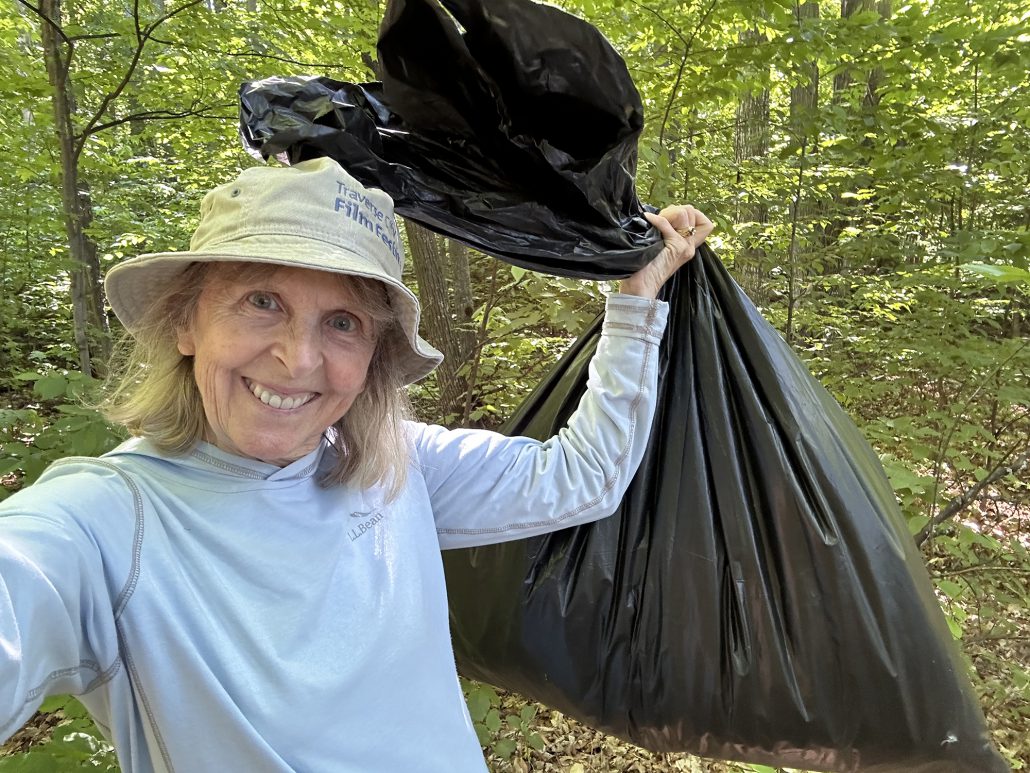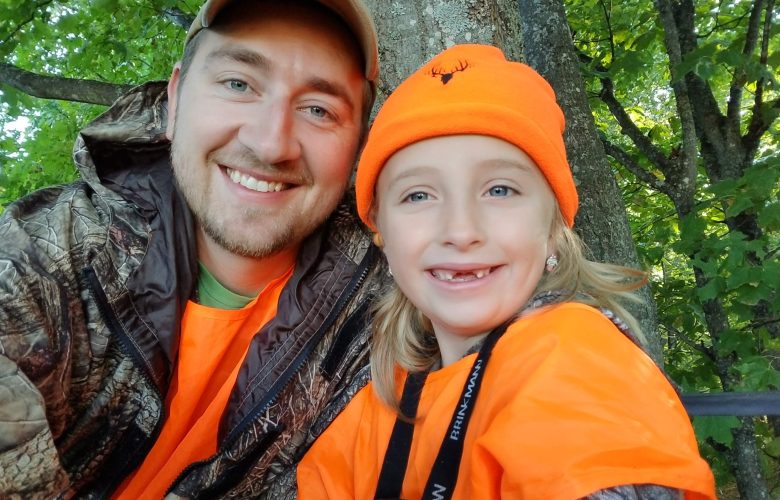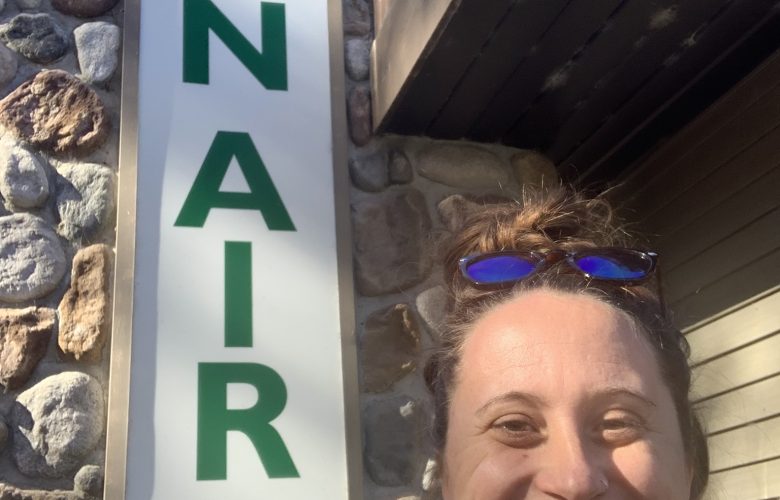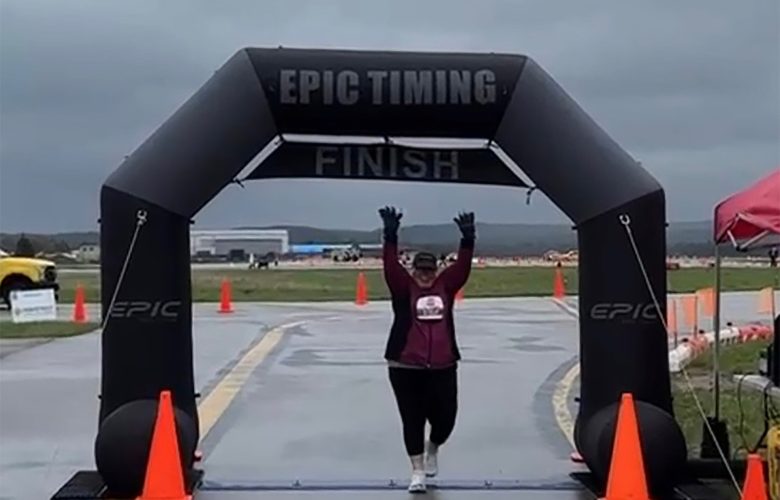Explore and support the Grand Traverse Regional Land Conservancy in Benzie County
By Bree McGregor
Current Contributor
When was the last time that you wandered down the winding path of a wooded trail, enjoyed the tartness of wild blackberries and the rich scent of wet soil and cedar, or stood beneath sun-dappled leaves to bathe in the gentle symphony of forest life?
No need to endure the icy shock of a polar plunge; it turns out that immersion in the woods offers its own host of health benefits—reduced stress, improved energy, and boosted immune system among them.
The Japanese call the practice of connecting with the natural world through our senses “shinrin-yoku,” which translates to “forest bath,” and a growing field of scientific research indicates that simply taking in the forest atmosphere through our senses can improve our physical and mental well-being.
Here in Benzie County, public access to forest-bathing opportunities abound, due in great part to the work of the Grand Traverse Regional Land Conservancy (GTRLC).
Land conservancies are nonprofit organizations that protect and care for the land by maintaining its natural scenic beauty, providing habitats for native species, and enhancing the quality of life in our communities for future generations. Many of GTRLC’s preserves in Benzie County offer public access to trails, lakes, and rivers.
Erin Anderson Whiting (46), senior charitable giving specialist for GTRLC, explains that GTRLC’s conservation efforts have become increasingly important as the popularity of our region continues to grow.
“As development skyrockets,” Whiting says, “we have to find a balance between economic development and inevitable growth—and preserving the things that call us to live here in the first place. GTRLC’s work provides a path by which people can help protect the very best of Northern Michigan for future generations to enjoy. “
Whiting, who is originally from Elk Rapids, has been involved with GTRLC off and on for more than seven years.
“My life-long love of the natural world drew me to the organization,” she explains, in reference to her return to Northern Michigan from New York City, and subsequently her initial communications role in the organization, before switching to charitable giving. “And seeing the real and lasting impact of the conservation work up close inspired me to deepen my own commitment to protecting our lands and waters.”
Her initial work with GTRLC included the organization’s ambitious Coastal Campaign to protect more than 6,000 acres of incredible dunes, forest, and farmland along the Lake Michigan coast from 2003-2007, after which, she stepped away to expand her professional experiences with Interlochen Center for the Arts for six years, and then as executive director of Parallel 45 Theatre for seven years.
“When an opportunity arose to re-join the Conservancy staff in early 2023, I was honored to return—exactly 20 years from my start date,” she says. “The full-circle nature of this feels fitting for an organization whose work is tied to the cyclical rhythm of the natural world.”
Land Conservancy in Benzie County
Since it was formed in 1991, GTRLC has acquired and protected natural, scenic, and farm lands across Antrim, Benzie, Grand Traverse, Kalkaska, and Manistee counties.
Within this region, it has established more than 300 conservation easements and 50 nature preserves and sanctuaries; in total, GTRLC has protected more than 47,000 acres of land and 155 miles of shoreline. It has cultivated 126 miles of trails and opened 80 properties to the public.
The numbers are impressive, and—through the continued support of invested communities, volunteers, and private donors—the numbers continue to grow.
GTRLC’s presence in Benzie County originated with a conservation easement by the Kraft family in 1991, the same year that GTRLC was founded: 25 acres of protected land at Watervale in Arcadia. Conservation easements are defined by GTRLC as “voluntary, perpetual agreements that restrict the way that land will be managed in order to protect natural resources and water quality.” According to the GTRLC 25th Anniversary Publication, printed in 2021, the Kraft family was among the first in Michigan to conserve easements on their land.
Since that very first conservation easement was created in Benzie County, land preservation efforts in this area have expanded.

Presently in Benzie County, 22 properties are owned or protected by GTRLC. These lands—open to the public—total more than 6,600 acres and include the 3,800-acre C.S. Mott Nature Preserve at Arcadia Dunes, which stretches across Benzie and Manistee counties.
These lands are classified by GTRLC into the following four categories: nature preserves; parks and natural areas; sanctuaries; and ecologically managed forests. Each classification indicates how the property is protected, owned, and managed. (Editor’s Note: Currently, GTRLC does not have ecologically managed forest land in Benzie County.)
Within Benzie County, there are nine nature preserves. These properties are protected, owned, and managed by GTRLC. Combined, the preserves host more than 30 miles of trails, where visitors can partake in birding, fishing, hiking, snowshoeing, hunting, kayaking/canoeing, mountain biking, skiing, and—of course—forest bathing.
One trail of note is the Arcadia Dunes Overlook at The C.S. Mott Nature Preserve. Perched 356 feet above Lake Michigan atop Old Baldy, this one-mile trail provides sweeping views and universal access for nature enthusiasts of all ages and abilities. Completed in early 2016, the trail is composed of boardwalk and crushed gravel that leads to a spacious platform overlook with wooden benches and wildlife kiosks. The trail is wheelchair accessible from the Baldy Trailhead parking lot off M-22, about 10 miles south of Frankfort. Arcadia Marsh, located off Northwood Highway/M-22, just south of Arcadia, is another wheelchair-accessible preserve.
Benzie County is also home to six parks and natural areas, totalling roughly 800 acres. Parks and natural areas are protected by GTRLC on behalf of local units of government, though they are technically owned and managed by these municipalities after their designated protection.
Among these lands is the two-acre Lake Ann Beach, an idyllic swimming and picnicking locale on 175 feet of Lake Ann frontage—with tables, grills, pavilions, and other amenities provided and maintained by Almira Township.
Another is Elberta Dunes South Natural Area, which offers a 0.8-mile hiking trail and a viewing platform with 360-degree views of Lake Michigan and the surrounding area.
There are also seven sanctuaries totalling approximately 245 acres in Benzie County. These are defined by GTRLC as property that is protected, owned, and managed by GTRLC. Because these are sensitive natural lands that contain exceptionally rare or rich natural features, no trails or infrastructure are present, and public use may be limited or even discouraged. Those who wish to explore these areas are encouraged—and in some cases required—to first contact GTRLC for permission, rules, and instructions.
GTRLC also holds conservation easements on a number of other properties in Benzie County which are privately owned and therefore not open to the public.
How To Preserve Land
The process of conserving land happens through a variety of partnerships.
“GTRLC frequently assists communities in creating public parks and natural areas that result in enhanced public access to nature and improved recreational opportunities,” Whiting explains. “[We do this] by working with local units of government to provide land-protection expertise and direct assistance with fundraising [from private and public sources], land acquisition, landowner negotiations, land improvement, stewardship, and much more.”
Whiting points to numerous examples in Benzie County: Elberta Dunes South (owned and managed by the Village of Elberta); Lake Ann Beach (Almira Township); Pearl Lake (State of Michigan); Platte River Park (Homestead Township); Railroad Point Natural Area (Benzie County); and Ransom Lake Natural Area (Almira Township).
“In the case of Railroad Point, for example,” Whiting says, “this beloved 66-acre property—with an abandoned railroad bed running along the shore [hence the name] on the south side of Crystal Lake—was high on the community’s list for permanent protection.”
At the time it was acquired, a developer was also eyeing the property for a 40-home development along the site’s prominent forested bluff.
“The Conservancy worked closely with Benzie County to negotiate the sale with the property owners,” Whiting explains. “To permanently remove development rights, to apply for [and receive] highly-competitive funding from the Michigan Natural Resources Trust Fund, and to raise the private dollars required by the Trust Fund for their local match.”
She continues:
“Working in partnership with Benzie County, over nearly 30 years, GTRLC has helped protect the Natural Area and four subsequent additions, bringing the Natural Area to more than 221 acres. The Natural Area includes a connector to the Betsie Valley Trail and offers stunning views of Crystal Lake. If you haven’t been there, it should be on your list, at any time of the year!”
Another good example of preservation through partnership is the new Platte River Park, which just opened officially in May. GTRLC purchased the property in 2018 under an agreement that it would be reimbursed, and the payback came fairly quickly from grants awarded by the Michigan Department of Natural Resources (DNR) and several foundations.
The key player behind the Platte River Park is Honor Area Restoration Project (HARP), which has raised almost $900,000 additional to establish a paved trail, several riverbank-viewing platforms, and a kayak and canoe launch.
HARP then donated the park to Homestead Township, though HARP remains intent on raising an endowment to ensure that the township has a permanent source of funds for its maintenance. Around $2 million more is needed to complete other assets, including a new entrance, a pavilion and picnic area, a trail system, a riverside boardwalk, and a walkway to the Honor village center. (Read more about Platte River Park in an article by Keith Schneider in the online archives of The Betsie Current.)
The GTRLC uses a landscape-level ecological analysis to determine long-term strategic goals for land conservation in Benzie County, according to Whiting, by identifying natural lands, forests, farmland, wetlands, water bodies, and Lake Michigan shoreline that have high conservation value and potential in Benzie County.
“As everyone in Benzie County knows, the pace of development pressure has increased—and will only continue to increase,” she says. “Our ability to meet that accelerated pace is directly related to our ability to raise funds, the majority of which come from generous individual donors, rather than public sources or private foundations.”
She continues:
“We all love Benzie County, but we don’t want to love it to death. Our job as an organization is to work with willing landowners, generous donors, and volunteers to find a way forward that balances smart development with permanent conservation of our most irreplaceable natural assets; once those are gone, they are gone forever, and no amount of money or regret will ever replace them.”
“Everyone has a valuable role to play,” she says.” If you’re interested in what we do, we would love to have you as a volunteer.”
Paula Dreeszen: Volunteer Extraordinaire
Pete’s Woods Trail—located just off Swamp Road in Blaine Township—is a GTRLC preserve, well known by locals as one of the best trails for enjoying spring wildflowers. Should you visit Pete’s Woods mid-spring, you will likely find trillium blooms and migratory birdsong, as well as local wildflower expert and GTRLC volunteer Paula Dreeszen (65).

Dreeszen’s official role with GTRLC is lead volunteer for the organization’s Southwestern Region, which includes Benzie County; Pete’s Woods is one of her favorite springtime trails.
After retiring from a career in engineering in Burlington, Wisconsin, Dreeszen and her husband relocated to Northern Michigan and began volunteering for GTRLC in 2005. The volunteer role offered Dreeszen something that engineering had not—abundant opportunities to enjoy the outdoors.
For nearly 20 years, Dreeszen has observed and supported the land’s improvement in a volunteer capacity, while continually learning about each preserve, its plants and animals.
“I particularly enjoy searching for the first blooming spring ephemeral flowers and looking for the first returning migratory songbirds,” Dreeszen says.
In her official role as lead volunteer, Dreeszen’s contributions to land stewardship are both physical and administrative. She spends significant time working within the preserves, and she also attends weekly staff meetings and supports communication between staff and volunteers, helping to assign volunteer jobs, such as trail maintenance.
In addition, Dreeszen explains:
“I am also busy with my own volunteer work: invasive species control [solo and helping to lead workdays], leading wildflower hikes, bird counts, trail maintenance, plant inventories, and more. I’ve also helped to create field guides to several preserves and to develop signage for the parking lot kiosks.”
Citizenship Via Environmental Stewardship
As GTRLC’s land conservation throughout the Southwest Region continues to grow, so does its need for community involvement in land preservation—to include volunteer trail work, conservation partnerships, and fundraising support.
Dreeszen’s current volunteer roster boasts 138 members, though she says not all are active. While many volunteers for trail work are retired from their careers—and/or are “empty nesters” whose children have grown up and left the home—others volunteer around work schedules or during college breaks and summer holidays. Diversity within her volunteer workforce is important.
“There’s a natural progression, as our volunteers get older and can’t do the more physically demanding tasks,” Dreeszen explains. ”So we constantly need younger people to volunteer and take on those jobs.”
One of GTRLC’s active projects in Benzie County is the Betsie Dunes Nature Sanctuary Addition.
The Betsie Dunes Nature Sanctuary is located between Lake Michigan and Crystal Lake, with more than 80 acres of healthy, forested dunes and almost 1,600 feet of undeveloped Lake Michigan shoreline.
“A proposed addition could incorporate a 2.5-acre inholding into the sanctuary, reconnecting a fragmented parcel that could otherwise be developed,” Whiting explains. “The property boasts a significant migration corridor for numerous bird species and serves as a home to the federally and state-listed rare Pitcher’s thistle plant [Cirsium pitcheri], which takes several years to bloom and is particularly sensitive to disturbance. It’s a stunning place. We are currently working to expand the protection of this property and preserve critical habitat for the plants and animals that call this place home.”
She adds:
“If we are successful in this effort, we would safeguard another 100 feet of Lake Michigan frontage and permanently protect important habitats, like northern mesic forest, open dunes, and the globally rare wooded dune and swale complex, only found along the Great Lakes.”
Like many of GTRLC’s conservation projects, the success of Betsie Dunes Nature Sanctuary Addition is contingent on fundraising and community support—so far, GTRLC has raised $115,027, which is 65 percent of the goal of $177,650.
Meanwhile, GTRLC’s smaller ongoing projects in Benzie County target invasive species removal—like baby’s breath and garlic mustard—and these efforts rely heavily on the support of volunteers.
“Most volunteer work happens between April and October,” Dreeszen says. “That’s when trails are built, overgrown vegetation along trails needs to be trimmed, trees fallen over trails need to be cleared, invasive plants are removed, native seeds are collected, and native plants are planted.”
She adds:
“All year long, we need volunteers to visit nature preserves—being the eyes and ears of the conservancy—and submit monitoring reports.”
Not all volunteer work requires the physicality of outdoor labor, however. In addition to the volunteers who help monitor and care for the land, Dreeszen says:
“[GTRLC] also needs volunteers for indoor tasks which support the mission of protecting significant natural, scenic, and farmlands in Benzie County and the other four counties where [GTRLC] operates.”
The volunteer calendar linked to the GTRLC website reveals regular opportunities to participate in scheduled trail maintenance, trail building, and invasive-species removal throughout the summer.
For instance, in July, volunteers can help to remove baby’s breath at Elberta Beach or trim vegetation at Arcadia Marsh, among other activities.
Volunteering with GTRLC is as simple as clicking a link and choosing an event to support.
There are two different ways to get involved in volunteer work—sign up to volunteer on the website, and GTRLC’s volunteer coordinator, Erica DesJardins, will contact you to match your interests to volunteer roles available. Or look at the volunteer workday calendar online, and sign up for any workday that interests you.
Prior experience or specialized knowledge is not required.
“If someone likes to work outdoors in nature—either independently or with other like-minded people at workdays—preserve stewardship work is rewarding and fun,” Dreeszen says.
Take a Hike… or a Forest Bath
Whether you decide to join the ranks of volunteer trail steward or to simply explore the land preserves in our area on your own or with friends/family, with more than 30 miles of trail to choose from in Benzie County, where should you begin? Dreezen and Whiting have a few recommendations to help launch you into the trails.
Dreeszen admits that her favorite Benzie County trails are numerous and vary by season. To name a few, she recommends Pete’s Woods for spring blooms, and Baldy Peak at Arcadia Dunes for dune flowers in June or really, she amends, anytime of year to enjoy the Lake Michigan view. She recommends strolling the boardwalk at Arcadia Marsh while enjoying an ice cream cone in August, when the wildflowers reach their peak. But truly, each trail offers its unique experiences and beauty, so an ambitious reader may endeavor to explore them all.
Whiting, likewise, struggled to name just one favorite.
“If I had to pick one,” she says, “it would be one that’s perhaps lesser known, but a true gem: Lower Woodcock Lake.”

Located farther afield near Interlochen, just southwest of Lake Ann, this 230-acre preserve contains an entire 22-acre undeveloped lake, as well as a half-mile of frontage on the Platte River, plus numerous other streams.
“You can meander more than 3.5 miles of trails and find yourself immersed in so many different natural scenes as you move through the property,” Whiting says. “The mirror-like surface of the unspoiled lake, the wide variety of bird species you regularly observe, the sound of the river rushing past like voices laughing and talking in a far-away distant room—these are just some of the reasons I love spending time there.”
Whatever trail you choose, Dreeszen and Whiting encourage you to enjoy the land responsibly.
“When you arrive at any GTRLC nature preserve, read the signs on the kiosk to learn preserve rules and what natural features and creatures you can expect to find there,” Dreeszen recommends.
“We are your land conservancy,” Whiting emphasizes. “Please get out on the trails and visit our preserves and natural areas. Explore a new place, or get to know an old favorite even better.”
So what are you waiting for? Explore a local GTRLC nature preserve—walk among the trees, open your senses, and begin to connect with the natural world.
Interested in volunteering with GTRLC? View opportunities and sign up at GTRLC.org/volunteer/signup online. Visit GTRLC.org to learn more about the organization or visit the Conservation Center, which is open to the public at 2846 3-Mile Road North in Traverse City.
Interested in learning more about the art and science of forest bathing? Read Dr. Qing Li’s Forest Bathing: How Trees Can Help You Find Health and Happiness. Related works are also available at Benzie County public libraries or The Bookstore in Frankfort.
Featured Photo Caption: Brett McGregor is a trail steward for the Grand Traverse Regional Land Conservancy, and on this day, he and the author, Bree, took their daughter, Esmé, with them to Baldy Dune while Brett cleared some downed trees. Photo courtesy of the McGregor family.




